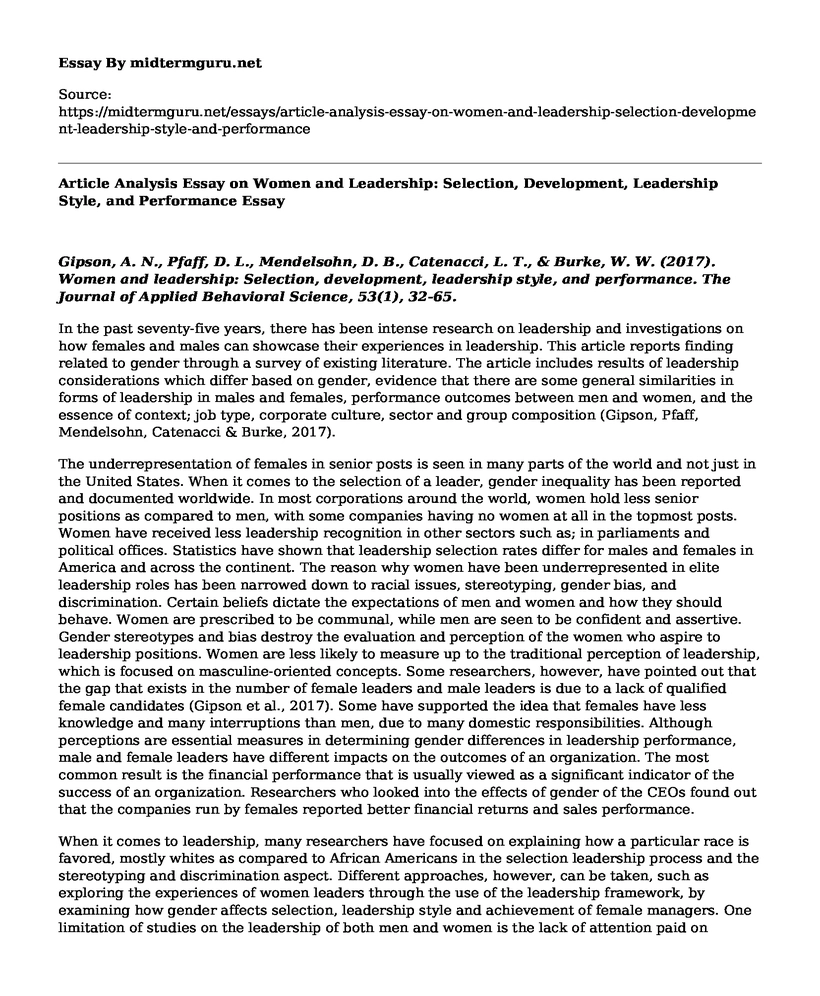Gipson, A. N., Pfaff, D. L., Mendelsohn, D. B., Catenacci, L. T., & Burke, W. W. (2017). Women and leadership: Selection, development, leadership style, and performance. The Journal of Applied Behavioral Science, 53(1), 32-65.
In the past seventy-five years, there has been intense research on leadership and investigations on how females and males can showcase their experiences in leadership. This article reports finding related to gender through a survey of existing literature. The article includes results of leadership considerations which differ based on gender, evidence that there are some general similarities in forms of leadership in males and females, performance outcomes between men and women, and the essence of context; job type, corporate culture, sector and group composition (Gipson, Pfaff, Mendelsohn, Catenacci & Burke, 2017).
The underrepresentation of females in senior posts is seen in many parts of the world and not just in the United States. When it comes to the selection of a leader, gender inequality has been reported and documented worldwide. In most corporations around the world, women hold less senior positions as compared to men, with some companies having no women at all in the topmost posts. Women have received less leadership recognition in other sectors such as; in parliaments and political offices. Statistics have shown that leadership selection rates differ for males and females in America and across the continent. The reason why women have been underrepresented in elite leadership roles has been narrowed down to racial issues, stereotyping, gender bias, and discrimination. Certain beliefs dictate the expectations of men and women and how they should behave. Women are prescribed to be communal, while men are seen to be confident and assertive. Gender stereotypes and bias destroy the evaluation and perception of the women who aspire to leadership positions. Women are less likely to measure up to the traditional perception of leadership, which is focused on masculine-oriented concepts. Some researchers, however, have pointed out that the gap that exists in the number of female leaders and male leaders is due to a lack of qualified female candidates (Gipson et al., 2017). Some have supported the idea that females have less knowledge and many interruptions than men, due to many domestic responsibilities. Although perceptions are essential measures in determining gender differences in leadership performance, male and female leaders have different impacts on the outcomes of an organization. The most common result is the financial performance that is usually viewed as a significant indicator of the success of an organization. Researchers who looked into the effects of gender of the CEOs found out that the companies run by females reported better financial returns and sales performance.
When it comes to leadership, many researchers have focused on explaining how a particular race is favored, mostly whites as compared to African Americans in the selection leadership process and the stereotyping and discrimination aspect. Different approaches, however, can be taken, such as exploring the experiences of women leaders through the use of the leadership framework, by examining how gender affects selection, leadership style and achievement of female managers. One limitation of studies on the leadership of both men and women is the lack of attention paid on ethnicity, race, and sexual orientation that affect diversity in leadership. Future studies on leadership processes for both men and women should consider ways in which women in various social identities experience leadership. When it comes to selecting women in the topmost leadership positions, women face challenges that prevent them from advancing as compared to their male associates (Gipson et al., 2017). When his issue is taken from multiple positions, it will ensure that females have more and better executive roles. Concerning decision making on leadership, it is vital to look into the mission of the organization, their strategy, culture, history, diversity, degree of globalization, and its goals regarding social responsibility.
Reference
Gipson, A. N., Pfaff, D. L., Mendelsohn, D. B., Catenacci, L. T., & Burke, W. W. (2017). Women and leadership: Selection, development, leadership style, and performance. The Journal of Applied Behavioral Science, 53(1), 32-65.
Cite this page
Article Analysis Essay on Women and Leadership: Selection, Development, Leadership Style, and Performance. (2023, Jan 15). Retrieved from https://midtermguru.com/essays/article-analysis-essay-on-women-and-leadership-selection-development-leadership-style-and-performance
If you are the original author of this essay and no longer wish to have it published on the midtermguru.com website, please click below to request its removal:
- Dominos Pizza Company Analysis - Paper Example
- Crisis Management Plan - Managment Paper Example
- Annotated Bibliography on Management: Collection Management Strategies in Hard Times
- Tesco PLC Analysis Paper Example
- Essay Sample on Strategies for Change Management
- Bed Bath & Beyond Inc: Careless Leadership Leads to Troubles - Case Study
- Strategic Development for Corp. ABC: Enabling Vision & Actions for Value & Opportunities - Essay Sample







